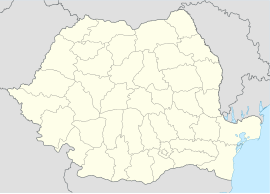Tășnad: Difference between revisions
Biruitorul (talk | contribs) That’s a separate commune |
|||
| Line 41: | Line 41: | ||
==Education== |
==Education== |
||
=== |
===Schools=== |
||
*[[Industrial School Group in Tășnad]] |
*[[Industrial School Group in Tășnad]] |
||
Revision as of 16:33, 27 June 2023
Tășnad
Tasnád | |
|---|---|
 | |
 Location in Satu Mare County | |
| Coordinates: 47°28′38″N 22°35′2″E / 47.47722°N 22.58389°E | |
| Country | Romania |
| County | Satu Mare |
| Government | |
| • Mayor (2020–2024) | Adrian-Dănuț Farcău[1] (PRO) |
Area | 96.60 km2 (37.30 sq mi) |
| Population (2021-12-01)[2] | 8,058 |
| • Density | 83/km2 (220/sq mi) |
| Time zone | EET/EEST (UTC+2/+3) |
| Vehicle reg. | SM |
| Website | www |
Tășnad (Romanian pronunciation: [təʃˈnad]; Hungarian: Tasnád, Hungarian pronunciation: [ˈtɒʃnaːd]; German: Trestenburg) is a town in Satu Mare County, Crișana, Romania. It administers five villages: Blaja (Tasnádbalázsháza), Cig (Csög), Rațiu (Ráctanya), Sărăuad (Tasnádszarvad) and Valea Morii (Tasnádmalomszeg).
At about 2 km from the center lies Tășnad geothermal Spa, known in Romania and abroad for its thermal waters.
Demographics
| Year | Pop. | ±% |
|---|---|---|
| 1977 | 9,934 | — |
| 1992 | 10,399 | +4.7% |
| 2002 | 10,188 | −2.0% |
| 2011 | 8,411 | −17.4% |
| Source: Census data | ||
According to the last census from 2011 there were 8,411 people living within the city.
Of this population, 51.1% are ethnic Romanians, while 36.2% are ethnic Hungarians, 11.4% ethnic Romani and 1,1% others.[3]
As of 2022, the city contains the Reformed Church, a Baptist Church, the Orthodox cathedral, a Roman Catholic church and a Greek Catholic church.[4]
Dr. Abraham Fuchs wrote a comprehensive historical book about Tășnad as it was up to World War II. The book is in Hebrew and describes the vibrant Jewish life in this small town up until its destruction in 1944.[5]
History
At the archaeological site of Tășnad-Sere in the Spa-area, finds from the Neolithic Körös, Pișcolt and Baden cultures have been made as well as remains from the late Iron Age and the migration period (Chernyakhov culture). Since 2012, Ulrike Sommer from the Institute of archaeology London conducts excavations of the Körös site together with the Satu Mare Museum.[6] Until 1876, Tășnad was part of Közép-Szolnok County when it was incorporated in the newly formed Szilágy County of the Kingdom of Hungary. In 1920, after the Treaty of Trianon it became part of the Kingdom of Romania.
Education
Schools
References
- ^ "Results of the 2020 local elections". Central Electoral Bureau. Retrieved 8 June 2021.
- ^ "Populaţia rezidentă după grupa de vârstă, pe județe și municipii, orașe, comune, la 1 decembrie 2021" (XLS). National Institute of Statistics.
- ^ "COMUNICAT DE PRESĂ : 02 februarie 2012 privind rezultatele provizorii ale Recensământului Populaţiei şi Locuinţelor – 2011" (PDF). Satumare.insse.ro. Retrieved 11 April 2018.
- ^ "Church". Google Maps. Google, Inc. Retrieved 24 April 2022.
- ^ "TASNAD". Tasnad.org. Retrieved 11 April 2018.
- ^ Astaloş, Ciprian; Sommer, Ulrike; Virág, Cristi (2013). "Excavations of an Early Neolithic Site at Tăşnad, Romania". Archaeology International. 16 (2012–2013): 47–53. doi:10.5334/ai.1614.



